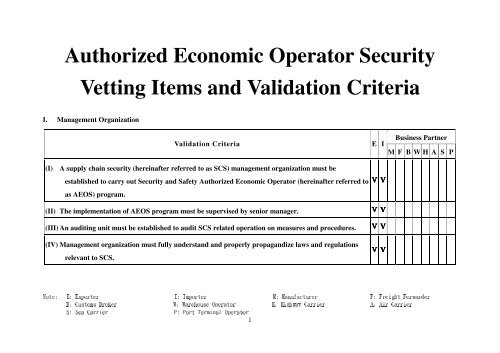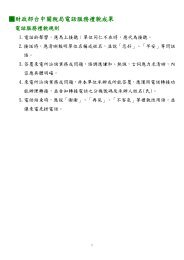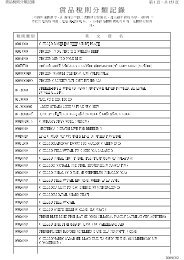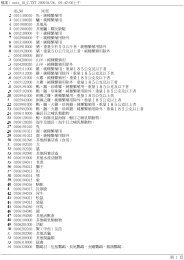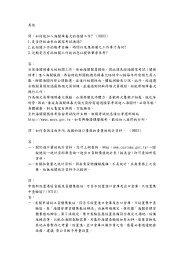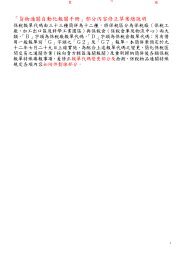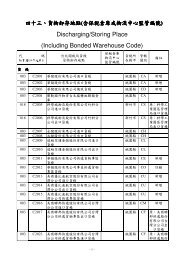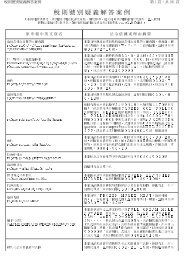Authorized Economic Operator Security Vetting Items and Validation ...
Authorized Economic Operator Security Vetting Items and Validation ...
Authorized Economic Operator Security Vetting Items and Validation ...
Create successful ePaper yourself
Turn your PDF publications into a flip-book with our unique Google optimized e-Paper software.
E: Exporter I: Importer M: Manufacturer F: Freight Forwarder<br />
B: Customs Broker W: Warehouse <strong>Operator</strong> H: Highway Carrier A: Air Carrier S: Sea Carrier P: Port Terminal <strong>Operator</strong> 1 Note:<br />
<strong>Authorized</strong> <strong>Economic</strong> <strong>Operator</strong> <strong>Security</strong><br />
<strong>Vetting</strong> <strong>Items</strong> <strong>and</strong> <strong>Validation</strong> Criteria<br />
I. Management Organization<br />
<strong>Validation</strong> Criteria<br />
E I<br />
Business Partner<br />
M F B W H A S P<br />
(I) A supply chain security (hereinafter referred to as SCS) management organization must be<br />
established to carry out <strong>Security</strong> <strong>and</strong> Safety <strong>Authorized</strong> <strong>Economic</strong> <strong>Operator</strong> (hereinafter referred to Ⅴ Ⅴ<br />
as AEOS) program.<br />
(II) The implementation of AEOS program must be supervised by senior manager. Ⅴ Ⅴ<br />
(III) An auditing unit must be established to audit SCS related operation on measures <strong>and</strong> procedures. Ⅴ Ⅴ<br />
(IV) Management organization must fully underst<strong>and</strong> <strong>and</strong> properly propag<strong>and</strong>ize laws <strong>and</strong> regulations<br />
relevant to SCS.<br />
Ⅴ Ⅴ
2<br />
II. Consultation, Cooperation <strong>and</strong> Communication<br />
<strong>Validation</strong> Criteria<br />
(I) SCS specialists:<br />
At least two staff members who have passed the AEOS SCS training conducted by the Customs or<br />
organization commissioned by the Customs must be designated to take charge of the company’s SCS<br />
operations.<br />
(II) Customs communication <strong>and</strong> consultation window:<br />
Must establish a specific accessible communication window to facilitate communication <strong>and</strong><br />
consultation with Customs.<br />
E I<br />
Ⅴ Ⅴ<br />
Ⅴ Ⅴ<br />
Business Partner<br />
M F B W H A S P<br />
III. Physical <strong>and</strong> Premises <strong>Security</strong><br />
(I) Building structure:<br />
<strong>Validation</strong> Criteria<br />
E I<br />
Business Partner<br />
M F B W H A S P<br />
1. Buildings must be constructed of materials that resist unlawful entry. Ⅴ Ⅴ Ⅴ Ⅴ Ⅴ Ⅴ Ⅴ Ⅴ Ⅴ Ⅴ<br />
2. The integrity of structures must be maintained by periodic inspection <strong>and</strong> repair. The results must<br />
be documented.<br />
Ⅴ Ⅴ Ⅴ Ⅴ Ⅴ Ⅴ Ⅴ Ⅴ Ⅴ Ⅴ
3<br />
<strong>Validation</strong> Criteria<br />
E I<br />
Business Partner<br />
M F B W H A S P<br />
(II) Proper fencing:<br />
1. The exterior of Cargo h<strong>and</strong>ling area (refer to areas that raw materials, semi-finished goods <strong>and</strong><br />
finished goods being processed, assembled, <strong>and</strong> packed) <strong>and</strong> storage facilities must be surrounded Ⅴ Ⅴ Ⅴ Ⅴ Ⅴ<br />
by appropriate fencing.<br />
2. Interior fencing must be used to segregate raw materials, finished goods, <strong>and</strong> hazardous items. Ⅴ Ⅴ Ⅴ Ⅴ Ⅴ<br />
3. All fencing must be maintained by periodic inspection <strong>and</strong> repair. The results must be<br />
documented.<br />
(III) Segregation of secure areas:<br />
Secure areas must be segregated to facilitate management.<br />
Ⅴ Ⅴ Ⅴ Ⅴ Ⅴ<br />
Ⅴ Ⅴ Ⅴ Ⅴ Ⅴ<br />
(IV) Locking devices <strong>and</strong> key controls:<br />
All external <strong>and</strong> internal windows, fences <strong>and</strong> gates must be secured with locking devices or other<br />
security compliance alternatives. Management or security personnel must control the issuance of all<br />
locks <strong>and</strong> keys.<br />
(V) Lighting:<br />
Adequate lighting must be provided inside <strong>and</strong> outside the facility including the following areas:<br />
entrances <strong>and</strong> exits, cargo h<strong>and</strong>ling <strong>and</strong> storage areas, fence lines <strong>and</strong> parking areas.<br />
Ⅴ Ⅴ Ⅴ Ⅴ Ⅴ Ⅴ Ⅴ Ⅴ Ⅴ Ⅴ<br />
Ⅴ Ⅴ Ⅴ Ⅴ Ⅴ Ⅴ Ⅴ Ⅴ Ⅴ Ⅴ
4<br />
<strong>Validation</strong> Criteria<br />
E I<br />
Business Partner<br />
M F B W H A S P<br />
(VI) Alarms <strong>and</strong> video surveillance systems:<br />
Alarm <strong>and</strong> video surveillance systems must be utilized to monitor premises <strong>and</strong> prevent<br />
unauthorized access to cargo h<strong>and</strong>ling <strong>and</strong> storage areas.<br />
(VII) <strong>Security</strong> personnel:<br />
Designated employees or the outsourced security company must be responsible for security.<br />
Ⅴ Ⅴ Ⅴ Ⅴ Ⅴ Ⅴ Ⅴ Ⅴ Ⅴ Ⅴ<br />
Ⅴ Ⅴ Ⅴ Ⅴ Ⅴ Ⅴ Ⅴ Ⅴ Ⅴ Ⅴ<br />
IV. Access Control<br />
<strong>Validation</strong> Criteria<br />
E I<br />
Business Partner<br />
M F B W H A S P<br />
(I) Gate control:<br />
1. Vehicles/personnel entering or exiting gates must be properly controlled. Ⅴ Ⅴ Ⅴ Ⅴ Ⅴ Ⅴ Ⅴ Ⅴ Ⅴ Ⅴ<br />
2. The number of gates should be kept to the minimum necessary for proper access <strong>and</strong> safety. Ⅴ Ⅴ Ⅴ Ⅴ Ⅴ Ⅴ Ⅴ Ⅴ Ⅴ Ⅴ<br />
(II) Personnel access identification system:<br />
1. Employee identification system:<br />
(1) An employee identification system must be in place to carry out positive identification <strong>and</strong><br />
access control.<br />
Ⅴ Ⅴ Ⅴ Ⅴ Ⅴ Ⅴ Ⅴ Ⅴ Ⅴ Ⅴ
<strong>Validation</strong> Criteria<br />
E I<br />
Business Partner<br />
M F B W H A S P<br />
(2) Employees must only be given access to those secure areas needed for the performance of their<br />
duties.<br />
Ⅴ Ⅴ Ⅴ Ⅴ Ⅴ Ⅴ Ⅴ Ⅴ Ⅴ Ⅴ<br />
(3) The issuance <strong>and</strong> removal of employee identification badges must be adequately controlled. Ⅴ Ⅴ Ⅴ Ⅴ Ⅴ Ⅴ Ⅴ Ⅴ Ⅴ Ⅴ<br />
(4) Procedures for the issuance, removal <strong>and</strong> changing of access devices (e.g. keys, key cards, etc.)<br />
must be documented.<br />
Ⅴ Ⅴ Ⅴ Ⅴ Ⅴ Ⅴ Ⅴ Ⅴ Ⅴ Ⅴ<br />
2. Visitor identification system:<br />
(1) Visitors (including suppliers) must present photo identification for documentation purposes<br />
upon arrival.<br />
Ⅴ Ⅴ Ⅴ Ⅴ Ⅴ Ⅴ Ⅴ Ⅴ Ⅴ Ⅴ<br />
(2) All visitors should be escorted <strong>and</strong> visibly display temporary identification. Ⅴ Ⅴ Ⅴ Ⅴ Ⅴ Ⅴ Ⅴ Ⅴ Ⅴ Ⅴ<br />
(3) Proper vendor ID verification mechanism must be in place. Ⅴ Ⅴ Ⅴ Ⅴ Ⅴ Ⅴ Ⅴ Ⅴ Ⅴ Ⅴ<br />
(III) Screening mechanism of arriving packages (including mail):<br />
Arriving packages <strong>and</strong> mail must be screened before being disseminated.<br />
(IV) Parking:<br />
Vehicles must only be parked in designated areas or spaces of secure areas.<br />
(V) Suspicious personnel:<br />
Procedures must be in place to report unauthorized access <strong>and</strong> unlawful entry.<br />
5<br />
Ⅴ Ⅴ Ⅴ Ⅴ Ⅴ Ⅴ Ⅴ Ⅴ Ⅴ Ⅴ<br />
Ⅴ Ⅴ Ⅴ Ⅴ Ⅴ Ⅴ Ⅴ Ⅴ Ⅴ Ⅴ<br />
Ⅴ Ⅴ Ⅴ Ⅴ Ⅴ Ⅴ Ⅴ Ⅴ Ⅴ Ⅴ
6<br />
<strong>Validation</strong> Criteria<br />
E I<br />
Business Partner<br />
M F B W H A S P<br />
(VI) Challenging <strong>and</strong> removing unauthorized persons:<br />
Procedures must be in place to identify, challenge <strong>and</strong> address unauthorized/unidentified persons.<br />
Ⅴ Ⅴ Ⅴ Ⅴ Ⅴ Ⅴ Ⅴ Ⅴ Ⅴ Ⅴ<br />
(VII) Additional physical access control measures for sea carriers:<br />
1. Access controls to vessels <strong>and</strong> cargo facilities:<br />
(1) Procedures for access controls of employees <strong>and</strong> visitors must be in place to prevent<br />
unauthorized entry to vessels <strong>and</strong> cargo facilities as well as to protect company assets.<br />
(2) Access controls must include the positive identification of all employees, visitors, service<br />
providers, government officials <strong>and</strong> vendors at all secure access points of entry.<br />
(3) Shore employees <strong>and</strong> service providers should only have access to those areas of the vessel<br />
where they have legitimate business. Vessel <strong>and</strong> facility access controls are governed by<br />
International Ship <strong>and</strong> Port <strong>Security</strong> Code (hereinafter referred to as ISPS) <strong>and</strong> the Maritime<br />
Transportation <strong>Security</strong> Act (hereinafter referred to as MTSA).<br />
Ⅴ<br />
Ⅴ<br />
Ⅴ<br />
2. Controlling vessel boarding <strong>and</strong> disembarking:<br />
(1) Consistent with the vessels’ ISPS security plan, all crew, employees, vendors <strong>and</strong> visitors may<br />
be subject to a search when boarding or disembarking vessels.<br />
Ⅴ
7<br />
<strong>Validation</strong> Criteria<br />
(2) A vessel visitor log must be maintained <strong>and</strong> a temporary visitor pass must be issued as required<br />
by the vessels’ security plan.<br />
(3) All crewmembers, employees, vendors <strong>and</strong> visitors, including government officials, must<br />
display proper identification, as required by the applicable ISPS/MTSA security plan.<br />
E I<br />
Business Partner<br />
M F B W H A S P<br />
Ⅴ<br />
Ⅴ<br />
V. Employee <strong>Security</strong><br />
<strong>Validation</strong> Criteria<br />
E I<br />
Business Partner<br />
M F B W H A S P<br />
(I) Requiring maintaining an employee list:<br />
Maintain a current employee list for internal <strong>and</strong> governmental checks.<br />
(II) Requiring pre-employment verification:<br />
Application information, such as employment history <strong>and</strong> references must be verified prior to<br />
employment.<br />
Ⅴ Ⅴ Ⅴ Ⅴ Ⅴ Ⅴ Ⅴ Ⅴ Ⅴ Ⅴ<br />
Ⅴ Ⅴ Ⅴ Ⅴ Ⅴ Ⅴ Ⅴ Ⅴ Ⅴ Ⅴ<br />
(III) Conducting background checks/investigations for prospective employees:<br />
An appropriate background check/investigation mechanism must be in place for prospective<br />
employees according to the sensitivity of specific work items, without violating the basic rights<br />
protected by laws <strong>and</strong> regulations.<br />
Ⅴ Ⅴ Ⅴ Ⅴ Ⅴ Ⅴ Ⅴ Ⅴ Ⅴ Ⅴ
8<br />
<strong>Validation</strong> Criteria<br />
E I<br />
Business Partner<br />
M F B W H A S P<br />
(IV) Conducting investigations for current employees:<br />
Companies must conduct periodic investigations for employees with sensitive positions or abnormal<br />
social activities or financial status.<br />
(V) Requiring denying access to terminated or transferred employees:<br />
Companies must have procedures in place to remove identification; facility <strong>and</strong> system access for<br />
terminated or transferred employees.<br />
Ⅴ Ⅴ Ⅴ Ⅴ Ⅴ Ⅴ Ⅴ Ⅴ Ⅴ Ⅴ<br />
Ⅴ Ⅴ Ⅴ Ⅴ Ⅴ Ⅴ Ⅴ Ⅴ Ⅴ Ⅴ<br />
VI. Procedural <strong>Security</strong><br />
<strong>Validation</strong> Criteria<br />
E I<br />
Business Partner<br />
M F B W H A S P<br />
(I) Requiring security procedures relevant to cargo transportation, h<strong>and</strong>ling, <strong>and</strong> storage:<br />
<strong>Security</strong> measures must be in place to ensure the integrity <strong>and</strong> security of processes relevant to the<br />
transportation, h<strong>and</strong>ling, <strong>and</strong> storage of cargo in the supply chain.<br />
Ⅴ Ⅴ Ⅴ Ⅴ Ⅴ Ⅴ Ⅴ Ⅴ Ⅴ Ⅴ<br />
(II) Requiring information accuracy:<br />
1. Requiring accurate document processing:
9<br />
<strong>Validation</strong> Criteria<br />
E I<br />
Business Partner<br />
M F B W H A S P<br />
(1) Procedures must be in place to ensure that all documentation used in the clearing of cargo, is<br />
legible, complete, accurate <strong>and</strong> protected against the exchange, loss or introduction of<br />
erroneous information.<br />
Ⅴ Ⅴ Ⅴ Ⅴ Ⅴ Ⅴ Ⅴ Ⅴ Ⅴ Ⅴ<br />
(2) Documentation control must include safeguarding computer access <strong>and</strong> information. Ⅴ Ⅴ Ⅴ Ⅴ Ⅴ Ⅴ Ⅴ Ⅴ Ⅴ Ⅴ<br />
2. Requiring accurate <strong>and</strong> timely manifest procedures:<br />
To help ensure the integrity of cargo received from abroad, procedures must be in place to ensure<br />
that information received from business partners is reported accurately <strong>and</strong> timely.<br />
Ⅴ Ⅴ Ⅴ Ⅴ Ⅴ Ⅴ Ⅴ Ⅴ Ⅴ<br />
3. Requiring shipping <strong>and</strong> receiving information against the cargo manifest (bill of lading):<br />
(1) Import cargo should be reconciled against the information on the bill of lading. Ⅴ Ⅴ Ⅴ Ⅴ Ⅴ Ⅴ Ⅴ Ⅴ<br />
(2) The weights, labels, marks <strong>and</strong> piece count of the import/export cargo must be accurately<br />
indicated.<br />
Ⅴ Ⅴ Ⅴ Ⅴ Ⅴ Ⅴ Ⅴ Ⅴ Ⅴ Ⅴ<br />
(3) Import/export cargo must be verified against purchase or delivery orders. Ⅴ Ⅴ Ⅴ Ⅴ Ⅴ Ⅴ Ⅴ Ⅴ Ⅴ Ⅴ<br />
(4) Drivers delivering or receiving cargo must be positively identified before cargo is received or<br />
released.<br />
Ⅴ Ⅴ Ⅴ Ⅴ Ⅴ Ⅴ Ⅴ Ⅴ Ⅴ Ⅴ<br />
4. Resolving <strong>and</strong> reporting cargo discrepancies:
10<br />
<strong>Validation</strong> Criteria<br />
E I<br />
Business Partner<br />
M F B W H A S P<br />
(1) All shortages, overages, <strong>and</strong> other significant discrepancies or anomalies must be resolved<br />
<strong>and</strong>/or investigated appropriately.<br />
(2) Customs <strong>and</strong>/or other appropriate law enforcement agencies must be notified if illegal or<br />
suspicious activities are detected – as appropriate.<br />
Ⅴ Ⅴ Ⅴ Ⅴ Ⅴ Ⅴ Ⅴ Ⅴ Ⅴ Ⅴ<br />
Ⅴ Ⅴ Ⅴ Ⅴ Ⅴ Ⅴ Ⅴ Ⅴ Ⅴ Ⅴ<br />
(III) Requiring additional or written procedural security measures for Customs brokers:<br />
1. Document processing:<br />
Measures must be in place to ensure that data transmitted by the Customs broker is accurate.<br />
Procedures must be in place to ensure that all information provided by the importer/exporter,<br />
freight forwarder, etc., <strong>and</strong> used in the clearing of cargo, is legible <strong>and</strong> protected against the<br />
exchange, loss or introduction of erroneous information.<br />
Ⅴ<br />
2. Ensuring consistent of information:<br />
Ensuring the consistency of information transmitted to Customs through the automatic clearance<br />
system with the information that appears on the transaction documents provided to the broker, with<br />
regard to such data as the supplier <strong>and</strong> consignee name <strong>and</strong> address, commodity description, weight,<br />
quantity <strong>and</strong> unit of measure (i.e. boxes, cartons, etc.) of the cargo being cleared.<br />
Ⅴ
11<br />
<strong>Validation</strong> Criteria<br />
3. Ensuring completed/clear documentation:<br />
Review of documentation for completeness <strong>and</strong> clarity <strong>and</strong> contracting the business partner or<br />
importer/exporter, as necessary, to obtain corrected documentation or information.<br />
4. Ensuring error-reporting procedures:<br />
To extent such information comes to the broker’s attention, alerting the importer/exporter of its<br />
obligation to notify Customs <strong>and</strong>/or shortages <strong>and</strong> overages of cargo that create a security risk in the<br />
supply chain.<br />
5. Requiring advance cargo information:<br />
Exporters/importers or their agents must submit Customs declaration within the time frame<br />
specified by domestic or foreign Customs prior to the cargo arriving at or departing from the port.<br />
(IV) Requiring additional procedural security measures for sea carriers:<br />
1. Complying with “Notice of Arrival <strong>and</strong> Departure” requirements for sea carriers:<br />
Sea carriers much ensure compliance with “Notice of Arrival <strong>and</strong> Departure” requirements so that<br />
accurate, timely <strong>and</strong> advanced transmission of data associated with international passengers <strong>and</strong><br />
crew is provided to government agencies <strong>and</strong> Customs.<br />
E I<br />
Business Partner<br />
M F B W H A S P<br />
Ⅴ<br />
Ⅴ<br />
Ⅴ<br />
Ⅴ
12<br />
<strong>Validation</strong> Criteria<br />
2. Providing BAPLIEs on request:<br />
At the request of Customs, sea carriers will provide a requested BAPLIE <strong>and</strong>/or stowage plan, in a<br />
format readily available.<br />
3. Such requests will be made on a voyage specific basis when Customs requires additional voyage<br />
information <strong>and</strong> will be honored by the sea carrier in a timely manner.<br />
E I<br />
Business Partner<br />
M F B W H A S P<br />
Ⅴ<br />
Ⅴ<br />
VII. Business Partner <strong>Security</strong><br />
<strong>Validation</strong> Criteria<br />
(I) Requiring written procedures for selecting business partners:<br />
E I<br />
Business Partner<br />
M F B W H A S P<br />
Taking supply chain security into consideration, the company must have written <strong>and</strong> verifiable<br />
process for the selection of business partners including Customs brokers, freight forwarders,<br />
manufacturers, suppliers, vendors, carriers, port terminal operators, consolidators, <strong>and</strong> warehouse<br />
operators.<br />
Ⅴ Ⅴ Ⅴ Ⅴ Ⅴ Ⅴ Ⅴ Ⅴ Ⅴ Ⅴ
<strong>Validation</strong> Criteria<br />
(II) Requiring documentation of partners’ AEOS certification:<br />
E I<br />
Business Partner<br />
M F B W H A S P<br />
For those business partners eligible for AEOS certification (carriers, port terminal operators,<br />
consolidators, warehouse operators, Customs brokers, freight forwarders, <strong>and</strong> manufacturers, etc.)<br />
the company must have documentation (e.g. photocopy of AEOS certificate) indicating these<br />
business partners are certified.<br />
Ⅴ Ⅴ Ⅴ Ⅴ Ⅴ Ⅴ Ⅴ Ⅴ Ⅴ Ⅴ<br />
(III) For non-AEOS partners, requiring written confirmation of meeting AEOS-equivalent security<br />
criteria:<br />
1. Requiring business partners without AEOS certificate to provide one of the following written<br />
documents demonstrating their compliance with security criteria:<br />
(1) Contractual document.<br />
(2) A completed self-assessment security questionnaire from the applicant.<br />
(3) A written statement from the business partner demonstrating their compliance with AEOS<br />
security criteria.<br />
(4) Senior business partner officer attesting to compliance.<br />
(5) Documents from the business partners demonstrating their compliance with an equivalent <strong>and</strong><br />
accredited security program administered by a foreign Customs authority.<br />
(6) A certificate issued by the domestic or foreign third-party security validation institution, which<br />
is publicly accepted by the Directorate General of Customs, Ministry of Finance.<br />
13<br />
Ⅴ Ⅴ Ⅴ Ⅴ Ⅴ Ⅴ Ⅴ Ⅴ Ⅴ Ⅴ
14<br />
<strong>Validation</strong> Criteria<br />
E I<br />
Business Partner<br />
M F B W H A S P<br />
2. Based upon a documented risk assessment process, non-AEOS eligible business partners must be<br />
subject to verification of compliance with AEOS security criteria by the applicant.<br />
(IV) Ensuring business partners develop security process <strong>and</strong> procedures consistent with AEOS security<br />
criteria to enhance the integrity of the shipment at point of origin.<br />
(V) Periodic reviews of business partners’ security condition:<br />
Periodic reviews of business partners’ processes <strong>and</strong> facilities should be conducted based on risk,<br />
<strong>and</strong> should maintain the security st<strong>and</strong>ards required by the company.<br />
Ⅴ Ⅴ Ⅴ Ⅴ Ⅴ Ⅴ Ⅴ Ⅴ Ⅴ Ⅴ<br />
Ⅴ Ⅴ Ⅴ Ⅴ Ⅴ Ⅴ Ⅴ Ⅴ Ⅴ Ⅴ<br />
Ⅴ Ⅴ Ⅴ Ⅴ Ⅴ Ⅴ Ⅴ Ⅴ Ⅴ Ⅴ<br />
(VI) Additional internal partner vetting processes:<br />
Requirements such as financial soundness, capability of meeting contractual security requirements,<br />
<strong>and</strong> the ability to identify <strong>and</strong> correct security deficiencies as needed, should be addressed by the<br />
company.<br />
(VII) Requiring assessment against a risk-based process as determined by a business partner management<br />
team.<br />
Ⅴ Ⅴ Ⅴ Ⅴ Ⅴ Ⅴ Ⅴ Ⅴ Ⅴ Ⅴ<br />
Ⅴ Ⅴ Ⅴ Ⅴ Ⅴ Ⅴ Ⅴ Ⅴ Ⅴ Ⅴ<br />
(VIII) Additional partner vetting processes for air carriers:<br />
1. Requiring periodic reviews of business partners’ security procedures at point of origin. Ⅴ
15<br />
<strong>Validation</strong> Criteria<br />
2. AEOS air carriers must ensure business partners develop security processes <strong>and</strong> procedures<br />
consistent with the AEOS security guidelines to enhance the integrity of the shipment at point of<br />
origin.<br />
E I<br />
Business Partner<br />
M F B W H A S P<br />
Ⅴ<br />
3. Requiring screening <strong>and</strong> selecting service providers. Ⅴ<br />
4. The AEOS air carrier should have documented service provider screening <strong>and</strong> selection procedures<br />
to screen the contracted service provider for validity, financial soundness, ability to meet<br />
contractual security requirements, <strong>and</strong> the ability to identify <strong>and</strong> correct security deficiencies as<br />
needed.<br />
5. Service provider procedures should utilize a risk-based process as determined by an internal<br />
management team.<br />
Ⅴ<br />
Ⅴ<br />
6. Screening customers:<br />
(1) The AEOS air carrier should have documented procedures to screen prospective customers for<br />
validity, financial soundness, the ability of meeting contractual security requirements, <strong>and</strong> the<br />
ability to identify <strong>and</strong> correct security deficiencies as needed.<br />
(2) Customer screening procedures should utilize a risk-based process as determined by an internal<br />
management team.<br />
Ⅴ<br />
Ⅴ
16<br />
<strong>Validation</strong> Criteria<br />
(IX) Additional partner vetting processes for sea carriers:<br />
E I<br />
Business Partner<br />
M F B W H A S P<br />
1. Requiring written procedures for screening new customers. Ⅴ<br />
2. Sea carriers must have written or web-based procedures for screening new customers to whom they<br />
issue bills of lading, which identify specific factors or practices, the presence of which would trigger<br />
additional scrutiny by the sea carrier.<br />
3. These procedures must also include a referral to Customs or other competent authorities for further<br />
review.<br />
4. The sea carrier must work with Customs to identify specific information regarding what factors,<br />
practices or risks are relevant.<br />
Ⅴ<br />
Ⅴ<br />
Ⅴ<br />
VIII. Cargo <strong>Security</strong><br />
<strong>Validation</strong> Criteria<br />
E I<br />
Business Partner<br />
M F B W H A S P<br />
(I) Cargo receiving management:<br />
1. Establishing procedures for the control of cargo receiving:
17<br />
<strong>Validation</strong> Criteria<br />
E I<br />
Business Partner<br />
M F B W H A S P<br />
(1) Requiring designated employees in contact with the delivery driver <strong>and</strong> in charge of cargo<br />
receiving.<br />
Ⅴ Ⅴ Ⅴ Ⅴ<br />
(2) Requiring registering <strong>and</strong> verifying shipping documents on cargo <strong>and</strong> documents required by the<br />
Ⅴ Ⅴ Ⅴ Ⅴ<br />
Customs.<br />
(3) Requiring recording the completion of inspection <strong>and</strong> the result. Ⅴ Ⅴ Ⅴ Ⅴ<br />
(4) Requiring active notifying procurement <strong>and</strong> administration departments of the completion of<br />
receiving cargo.<br />
Ⅴ Ⅴ Ⅴ Ⅴ<br />
(5) Requiring delivering cargo to the designated areas to prevent the cargo from being unsupervised. Ⅴ Ⅴ Ⅴ Ⅴ<br />
2. Inspecting the seals on cargo delivered:<br />
Procedures of inspecting seals must be in place for verifying the intact of the seals when receiving<br />
cargo.<br />
3. Designating storage areas with marks:<br />
Requiring designated cargo storage areas being clearly marked.<br />
4. Making an inventory or weighing:<br />
St<strong>and</strong>ard operation procedures must be in place for making an inventory or weighing of the cargo.<br />
Ⅴ Ⅴ Ⅴ Ⅴ<br />
Ⅴ Ⅴ Ⅴ Ⅴ<br />
Ⅴ Ⅴ Ⅴ Ⅴ<br />
5. Management procedures of cargo receiving:
18<br />
<strong>Validation</strong> Criteria<br />
E I<br />
Business Partner<br />
M F B W H A S P<br />
(1) Management procedures of cargo receiving must be in place. Ⅴ Ⅴ Ⅴ Ⅴ<br />
(2) Requiring needed documents, arriving time <strong>and</strong> designated management personnel for cargo<br />
receiving.<br />
Ⅴ Ⅴ Ⅴ Ⅴ<br />
(3) Requiring verifying cargo based on purchase order <strong>and</strong> cargo list. Ⅴ Ⅴ Ⅴ Ⅴ<br />
(4) Requiring completing storage registration right after receiving the cargo. Ⅴ Ⅴ Ⅴ Ⅴ<br />
6. Internal control procedures:<br />
(1) Internal control procedures must be in place for dealing with anomalies or discrepancies of cargo<br />
Ⅴ Ⅴ Ⅴ Ⅴ<br />
receiving.<br />
(2) Requiring different departments or personnel being in charge of ordering (procurement),<br />
receiving <strong>and</strong> registering (warehouse management), <strong>and</strong> payment (disbursement).<br />
Ⅴ Ⅴ Ⅴ Ⅴ<br />
(II) Cargo storage management:<br />
1. Designating cargo storage areas:<br />
Requiring designating areas for cargo storage.<br />
Ⅴ Ⅴ Ⅴ Ⅴ<br />
2. Internal control procedures:<br />
(1) Procedures for inventory h<strong>and</strong>ling must be in place. Ⅴ Ⅴ Ⅴ Ⅴ
19<br />
<strong>Validation</strong> Criteria<br />
E I<br />
Business Partner<br />
M F B W H A S P<br />
(2) Procedures for dealing with anomalies or discrepancies must be in place. Ⅴ Ⅴ Ⅴ Ⅴ<br />
3. Separating storage for different cargo:<br />
(1) Requiring separated storage for different types of cargo (e.g. hazardous cargo, damaged cargo,<br />
chemicals etc).<br />
(2) Requiring registering on the logistics management system when the cargo is delivered to the<br />
storage area.<br />
4. Additional security measures for receiving cargo:<br />
Requiring security measures or additional security methods to protect cargo against access of<br />
unauthorized personnel.<br />
5. Authorization level for different type of employees:<br />
Requiring only designated staff <strong>and</strong> authorized personnel are allowed to access storage areas <strong>and</strong><br />
cargo.<br />
Ⅴ Ⅴ Ⅴ Ⅴ<br />
Ⅴ Ⅴ Ⅴ Ⅴ<br />
Ⅴ Ⅴ Ⅴ Ⅴ<br />
Ⅴ Ⅴ Ⅴ Ⅴ<br />
(III) Management of cargo production:<br />
1. Designating production areas:<br />
(1) Requiring designating areas for production. Ⅴ
20<br />
<strong>Validation</strong> Criteria<br />
(2) Requiring security measures <strong>and</strong> designating management personnel to ensure the integrity <strong>and</strong><br />
security of cargo if it is outsourced.<br />
2. Internal control procedures:<br />
(1) Securing production procedures to ensure the integrity <strong>and</strong> security of cargo in the process of<br />
production.<br />
(2) Requiring only designated technicians, authorized personnel or supervisors are allowed to access<br />
cargo.<br />
E I<br />
Business Partner<br />
M F B W H A S P<br />
Ⅴ<br />
Ⅴ<br />
Ⅴ<br />
(3) Requiring a system or designated employees to supervise the process of production. Ⅴ<br />
(4) Requiring different departments in charge of manufacturing <strong>and</strong> production procedures. Ⅴ<br />
3. Additional security measures for access to cargo:<br />
Requiring security measures or additional security methods in the process of production to protect<br />
cargo from the access of unauthorized personnel.<br />
4. Employee authorization level <strong>and</strong> classification:<br />
Requiring only designated technicians <strong>and</strong> authorized personnel are allowed to access cargo.<br />
5. Quality inspection:<br />
Quality inspection procedures must be in place to further ensure the security <strong>and</strong> integrity of cargo.<br />
Ⅴ<br />
Ⅴ<br />
Ⅴ
21<br />
<strong>Validation</strong> Criteria<br />
E I<br />
Business Partner<br />
M F B W H A S P<br />
(IV) Loading management:<br />
1. Routine check of cargo:<br />
(1) Requiring designated personnel in contact with the delivery driver <strong>and</strong> in charge of cargo<br />
loading.<br />
(2) Requiring registering <strong>and</strong> verifying the shipping documents on cargo <strong>and</strong> the documents<br />
required by the Customs.<br />
(3) Requiring verifying cargo, shipping documents on cargo <strong>and</strong> the documents required by the<br />
Customs.<br />
Ⅴ Ⅴ Ⅴ<br />
Ⅴ Ⅴ Ⅴ<br />
Ⅴ Ⅴ Ⅴ<br />
(4) Requiring recording the completion of inspection <strong>and</strong> the result. Ⅴ Ⅴ Ⅴ<br />
(5) Sales <strong>and</strong> administration department must be actively notified of the cargo status as it is shipped<br />
from the company.<br />
2. Loading supervision:<br />
Requiring designating personnel in charge of supervising the loading of cargo.<br />
3. Consistent marking:<br />
Requiring cargo to be shipped must be consistently marked <strong>and</strong> stored in designated areas.<br />
Ⅴ Ⅴ Ⅴ<br />
Ⅴ Ⅴ Ⅴ<br />
Ⅴ Ⅴ Ⅴ
22<br />
<strong>Validation</strong> Criteria<br />
E I<br />
Business Partner<br />
M F B W H A S P<br />
4. Weighing cargo with record:<br />
Operation procedures must be in place for making an inventory <strong>and</strong> weighing cargo with record.<br />
Ⅴ Ⅴ Ⅴ<br />
5. Management process of cargo loading <strong>and</strong> delivery:<br />
(1) Requiring needed documents, time <strong>and</strong> management personnel for cargo loading, <strong>and</strong> they must<br />
be consistent with shipping record of warehouse management.<br />
Ⅴ Ⅴ Ⅴ<br />
(2) Requiring verifying cargo based on shipping list. Ⅴ Ⅴ Ⅴ<br />
(3) Requiring completing the shipping registration as the cargo is shipped from the company <strong>and</strong><br />
must be consistent with the shipping record of warehouse management.<br />
6. Sealing of the cargo to be shipped:<br />
Requiring verifying <strong>and</strong> sealing export cargo to be shipped in accordance with Customs regulations.<br />
7. Internal control procedures:<br />
Internal control procedures must be in place for dealing with anomalies or discrepancies of cargo to<br />
be shipped.<br />
Ⅴ Ⅴ Ⅴ<br />
Ⅴ Ⅴ Ⅴ Ⅴ Ⅴ<br />
Ⅴ Ⅴ Ⅴ Ⅴ Ⅴ Ⅴ Ⅴ<br />
(V) Management of cargo to be exported:
23<br />
<strong>Validation</strong> Criteria<br />
1. <strong>Security</strong> measures must be in place for export cargo delivered by trucks, bonded trucks, bonded<br />
cartons, or containers to export warehouses, terminal operators, or export ports to protect against<br />
loss, theft, or damage.<br />
E I<br />
Business Partner<br />
M F B W H A S P<br />
(1) The seals for containerized export cargo must meet or exceed the current ISO PAS 17712<br />
st<strong>and</strong>ards (e.g. electronic seal) for high security seals.<br />
(2) Requiring using seals issued or authorized by Customs for export cargo shipped by bonded<br />
trucks or bonded cartons.<br />
(3) Proper security measures for export cargo delivered by truck must be in place to ensure cargo<br />
security.<br />
Ⅴ Ⅴ Ⅴ Ⅴ Ⅴ<br />
Ⅴ Ⅴ Ⅴ Ⅴ Ⅴ<br />
Ⅴ Ⅴ<br />
2. Requiring drivers to check the integrity of seals <strong>and</strong> record the result before delivering export cargo. Ⅴ Ⅴ Ⅴ Ⅴ<br />
(VI) Maintaining logistics data:<br />
Ensuring the integrity <strong>and</strong> correctness of the content of the documents/electronic data of cargo<br />
transaction, logistics, <strong>and</strong> Customs clearance with a mechanism to protect against tampering,<br />
exchange, or loss.<br />
Ⅴ Ⅴ Ⅴ Ⅴ Ⅴ Ⅴ Ⅴ Ⅴ Ⅴ<br />
(VII) Additional container security requirements for warehouses:
24<br />
<strong>Validation</strong> Criteria<br />
1. Requiring complying with relevant regulations governing Customs management of warehouses (e.g.<br />
warehouses, bonded warehouses, logistics centers, terminal operators, etc.)<br />
2. St<strong>and</strong>ard operation procedures must be in place for controlling the storage, withdrawal, <strong>and</strong><br />
transfer of container/cargo.<br />
3. <strong>Security</strong> measures for cargo storage areas must be in place to protect against the access of<br />
unauthorized personnel.<br />
4. Adequate measures must be in place to protect against unauthorized movement, exchange, or<br />
damage.<br />
E I<br />
Business Partner<br />
M F B W H A S P<br />
Ⅴ<br />
Ⅴ<br />
Ⅴ<br />
Ⅴ<br />
IX. Container <strong>Security</strong><br />
<strong>Validation</strong> Criteria<br />
E I<br />
Business Partner<br />
M F B W H A S P<br />
(I) Requiring secure container storage:<br />
Containers must be stored in a secure area to prevent unauthorized access <strong>and</strong>/or manipulation.<br />
Ⅴ Ⅴ Ⅴ Ⅴ Ⅴ Ⅴ Ⅴ Ⅴ<br />
(II) Requiring container integrity at point of stuffing:
<strong>Validation</strong> Criteria<br />
E I<br />
Business Partner<br />
M F B W H A S P<br />
1. Container integrity must be maintained to protect against the introduction of unauthorized material<br />
<strong>and</strong>/or persons.<br />
2. At the point of stuffing, procedures must be in place to properly seal <strong>and</strong> maintain the integrity of<br />
the shipping containers.<br />
Ⅴ Ⅴ Ⅴ Ⅴ Ⅴ Ⅴ Ⅴ Ⅴ<br />
Ⅴ Ⅴ Ⅴ Ⅴ Ⅴ Ⅴ Ⅴ Ⅴ<br />
(III) Transmission of container/cargo movement message:<br />
Requiring relevant business of import, export, transit <strong>and</strong> transshipment transmitting container<br />
information to the Dynamic Tracking System of Containers (Cargoes) in accordance with<br />
“Operational Directions for the Dynamic Tracking System of Containers (Cargoes)”.<br />
Ⅴ Ⅴ Ⅴ Ⅴ Ⅴ Ⅴ Ⅴ<br />
(IV) Container security:<br />
1. Procedures must be in place to verify the physical integrity of the container structure prior to<br />
stuffing, to include the reliability of the locking mechanisms of the doors.<br />
Ⅴ Ⅴ Ⅴ Ⅴ Ⅴ Ⅴ<br />
2. A seven-point inspection process is required for loaded containers.<br />
(1) Inside/outside doors Ⅴ Ⅴ Ⅴ Ⅴ Ⅴ Ⅴ<br />
(2) Front wall Ⅴ Ⅴ Ⅴ Ⅴ Ⅴ Ⅴ<br />
(3) Left side Ⅴ Ⅴ Ⅴ Ⅴ Ⅴ Ⅴ<br />
(4) Right side Ⅴ Ⅴ Ⅴ Ⅴ Ⅴ Ⅴ<br />
25
26<br />
<strong>Validation</strong> Criteria<br />
E I<br />
Business Partner<br />
M F B W H A S P<br />
(5) Floor Ⅴ Ⅴ Ⅴ Ⅴ Ⅴ Ⅴ<br />
(6) Ceiling/Roof Ⅴ Ⅴ Ⅴ Ⅴ Ⅴ Ⅴ<br />
(7) Outside/undercarriage Ⅴ Ⅴ Ⅴ Ⅴ Ⅴ Ⅴ<br />
(V) Requiring ISO PAS 17712 st<strong>and</strong>ard high security seals:<br />
All seal must meet or exceed the current ISO PAS 17712 st<strong>and</strong>ards for high security seals.<br />
Ⅴ Ⅴ Ⅴ Ⅴ Ⅴ Ⅴ Ⅴ Ⅴ<br />
(VI) Controlling container seals:<br />
1. Written procedures must stipulate how seals are to be controlled <strong>and</strong> affixed to loaded containers. Ⅴ Ⅴ Ⅴ Ⅴ Ⅴ Ⅴ Ⅴ Ⅴ<br />
2. Procedures must be in place for recognizing <strong>and</strong> reporting compromised seals <strong>and</strong>/or containers to<br />
Customs.<br />
3. Requiring designated units or employees to distribute container seals <strong>and</strong> record the use of seals for<br />
integrity purposes.<br />
(VII) Management of empty containers:<br />
Requiring a mechanism (including designated areas, periodic patrol, etc.) to protect against<br />
unauthorized access.<br />
Ⅴ Ⅴ Ⅴ Ⅴ Ⅴ Ⅴ Ⅴ Ⅴ<br />
Ⅴ Ⅴ Ⅴ Ⅴ Ⅴ Ⅴ Ⅴ Ⅴ<br />
Ⅴ Ⅴ Ⅴ Ⅴ Ⅴ Ⅴ Ⅴ Ⅴ
27<br />
X. Conveyance <strong>Security</strong><br />
<strong>Validation</strong> Criteria<br />
(I) Requiring maintaining management procedures for security of conveyance (e.g. trucks, vessels,<br />
aircrafts etc.):<br />
E I<br />
Business Partner<br />
M F B W H A S P<br />
1. Procedures must be in place for preventing unauthorized entry into conveyance to ensure<br />
conveyance security.<br />
Ⅴ Ⅴ Ⅴ Ⅴ Ⅴ Ⅴ Ⅴ<br />
2. <strong>Security</strong> measures for conveyance:<br />
(1) Requiring periodic search of internal/external cargo hold for suspicious persons or goods. Ⅴ Ⅴ Ⅴ Ⅴ Ⅴ Ⅴ Ⅴ<br />
(2) Securing all internal/external compartments, or walls/doors of vessels <strong>and</strong> aircraft. Ⅴ Ⅴ<br />
(3) Procedures must be in place to address unauthorized entry or other illegal cases. Ⅴ Ⅴ Ⅴ Ⅴ Ⅴ Ⅴ Ⅴ Ⅴ<br />
(4) Procedures must be in place to address unmanifested goods in vessels or aircraft. Ⅴ Ⅴ Ⅴ Ⅴ<br />
3. Routes for receiving <strong>and</strong> delivering cargo must be predetermined. Ⅴ Ⅴ Ⅴ Ⅴ Ⅴ<br />
4. Ensuring confidentiality of the cargo to be loaded <strong>and</strong> the planned routes <strong>and</strong> destinations. Ⅴ Ⅴ Ⅴ Ⅴ Ⅴ<br />
5. Management procedures must be in place for keys, parking areas, fueling, <strong>and</strong> unplanned stops. Ⅴ Ⅴ Ⅴ Ⅴ Ⅴ<br />
6. Procedures must be in place for reporting incidents or emergencies. Ⅴ Ⅴ Ⅴ Ⅴ Ⅴ Ⅴ Ⅴ
28<br />
<strong>Validation</strong> Criteria<br />
E I<br />
Business Partner<br />
M F B W H A S P<br />
7. Procedures must be in place for reporting anomalies of cargo or seals. Ⅴ Ⅴ Ⅴ Ⅴ Ⅴ Ⅴ Ⅴ<br />
(II) Additional security requirements for air carriers:<br />
1. Requiring procedures for maintaining aircraft integrity. Ⅴ<br />
2. Aircraft integrity must be maintained to protect against the introduction of unauthorized personnel<br />
<strong>and</strong> material.<br />
3. Conveyance security procedures must include the physical search of all readily accessible areas,<br />
securing all internal/external compartments <strong>and</strong> panels <strong>and</strong> reporting cases in which unmanifested<br />
materials or signs of tampering are discovered.<br />
Ⅴ<br />
Ⅴ<br />
(III) Requiring additional security measures for highway carriers, or documentation of compliance with<br />
AEOS security criteria:<br />
1. Requiring conveyance tracking <strong>and</strong> monitoring procedures:<br />
(1) En route conveyance security:<br />
Highway carriers must ensure that conveyance <strong>and</strong> trailer integrity is maintained while the<br />
conveyance is en route transporting cargo to export/import points or import/transit containers<br />
by utilizing a tracking <strong>and</strong> monitoring activity log or records.<br />
Ⅴ
29<br />
<strong>Validation</strong> Criteria<br />
(2) Predetermined routes <strong>and</strong> r<strong>and</strong>om security checks:<br />
Predetermined routes must be identified by the dispatcher, <strong>and</strong> procedures must consist of<br />
r<strong>and</strong>om route checks along with documenting <strong>and</strong> verifying the length of time between the<br />
loading point/trailer pickup <strong>and</strong> the delivery destinations.<br />
(3) Notification of route delays:<br />
Drivers should notify the dispatcher of any route delays due to weather, traffic <strong>and</strong>/or rerouting.<br />
(4) Periodic, unannounced <strong>and</strong> documented checks by carrier management:<br />
Highway carrier management must perform a documented, periodic, <strong>and</strong> unannounced<br />
verification process to ensure the logs are maintained <strong>and</strong> conveyance tracking <strong>and</strong> monitoring<br />
procedures are being followed <strong>and</strong> enforced.<br />
E I<br />
Business Partner<br />
M F B W H A S P<br />
Ⅴ<br />
Ⅴ<br />
Ⅴ<br />
2. Conveyance inspection procedures: Ⅴ<br />
(1) Using a checklist for conveyances inspection:<br />
Using a checklist, drivers should be trained to inspect their conveyances for security.<br />
(2) Training in conveyance searches:<br />
Training in conveyance searches should be adopted as part of the company’s on-the-job training<br />
program.<br />
Ⅴ<br />
Ⅴ
30<br />
<strong>Validation</strong> Criteria<br />
(3) Inspecting conveyance upon both entering <strong>and</strong> exiting truck yard:<br />
Conveyance inspections must be completed upon entering <strong>and</strong> departing from the truck yard<br />
<strong>and</strong> at the last point of loading prior to export <strong>and</strong>/or import.<br />
(4) R<strong>and</strong>om search by security managers:<br />
To counter internal conspiracies, supervisory personnel or a security manager, held accountable<br />
to senior management for security, must search the conveyance after the driver has conducted a<br />
search.<br />
E I<br />
Business Partner<br />
M F B W H A S P<br />
Ⅴ<br />
Ⅴ<br />
(5) Searches must be r<strong>and</strong>om, documented, <strong>and</strong> based on risk. Ⅴ<br />
(6) Searches must be conducted at the truck yard <strong>and</strong> after the truck has been loaded <strong>and</strong> en route<br />
to import <strong>and</strong>/or export.<br />
Ⅴ<br />
(IV) Requiring additional security measures for bonded trucks, or documentation of compliance with<br />
AEOS security criteria:<br />
1. Requiring loading/unloading vigilance:<br />
Highway carriers must be vigilant to help ensure that the merch<strong>and</strong>ise is legitimate <strong>and</strong> that there is<br />
no loading of contrab<strong>and</strong> at the loading lock/manufacturing facility.<br />
Ⅴ
31<br />
<strong>Validation</strong> Criteria<br />
2. Requiring secure bonded trucks storage:<br />
Bonded trucks must be stored in a secure area to prevent unauthorized access <strong>and</strong>/or manipulation.<br />
Procedures must be in place for reporting unauthorized entry into or storage in correct areas.<br />
3. Requiring bounded truck seals:<br />
(1) Based on risk, a high security barrier bolt seal must be applied to the door h<strong>and</strong>le <strong>and</strong>/or a cable<br />
seal must be applied to the vertical bar on the bonded truck doors.<br />
E I<br />
Business Partner<br />
M F B W H A S P<br />
Ⅴ<br />
Ⅴ<br />
(2) All seal must meet or exceed the current ISO PAS 17712 st<strong>and</strong>ards for high security seals. Ⅴ<br />
4. Requiring procedures for treatment of goods in transit:<br />
(1) Clearly defined written procedures must stipulate how seals in the highway carrier’s possession<br />
are to be controlled during transit.<br />
Ⅴ<br />
(2) These written procedures must be briefed to all drivers. Ⅴ<br />
(3) There must be a mechanism to ensure that these procedures are understood <strong>and</strong> are being<br />
followed.<br />
Ⅴ<br />
5. Requiring procedures for treatment of goods in transit include:<br />
(1) Verifying that the seal is intact, <strong>and</strong> if it exhibits evidence of tampering along the route. Ⅴ
32<br />
<strong>Validation</strong> Criteria<br />
E I<br />
Business Partner<br />
M F B W H A S P<br />
(2) Verify that the seal number is the same as stated on the shipping documents. Ⅴ<br />
(3) Properly documenting the original <strong>and</strong> second seal numbers. Ⅴ<br />
(4) The driver must immediately notify the dispatcher that the seal was broken, by whom; <strong>and</strong> the<br />
number of the second seal that is placed on the bonded truck.<br />
(5) The carrier must immediately notify the relevant partners or authorities of the placement of the<br />
second seal.<br />
Ⅴ<br />
Ⅴ<br />
(V) Additional security requirements for port terminal operators:<br />
1. Requiring protecting conveyance against tampering. Ⅴ<br />
2. Conveyance/vessel integrity must be maintained to protect against the introduction of unauthorized<br />
personnel <strong>and</strong> material.<br />
3. Conveyance/vessel security procedures must include the physical search of all readily accessible<br />
areas, securing all internal/external compartments, panels <strong>and</strong> reporting cases in which<br />
unmanifested materials or signs of tampering are discovered.<br />
4. Requiring full collaboration with other business entities at ports for inspection <strong>and</strong> transmission of<br />
real-time trade data, container (cargo) status <strong>and</strong> high-risk targets.<br />
Ⅴ<br />
Ⅴ<br />
Ⅴ
33<br />
<strong>Validation</strong> Criteria<br />
5. While at port, the pier <strong>and</strong> waterside of vessel must be adequately illuminated. Limit shore<br />
employees <strong>and</strong> service providers to those areas of the vessel where they have legitimate business.<br />
6. Requiring constant contact with CSI local representatives to discuss supply chain security issues<br />
with further improvement in which the international port is deployed with CSI representatives.<br />
E I<br />
Business Partner<br />
M F B W H A S P<br />
Ⅴ<br />
Ⅴ<br />
XI. Information Technology <strong>Security</strong><br />
(I) Information security management:<br />
<strong>Validation</strong> Criteria<br />
E I<br />
Business Partner<br />
M F B W H A S P<br />
1. Proper procedures of information security management must be in place to protect information<br />
system against unauthorized access or misuse.<br />
2. Automated systems can only be accessed with individually assigned accounts, <strong>and</strong> they must be<br />
protected with passwords that must be changed periodically.<br />
3. IT security policies, procedures <strong>and</strong> st<strong>and</strong>ards must be in place <strong>and</strong> provided to employees in the<br />
form of annual training.<br />
Ⅴ Ⅴ Ⅴ Ⅴ Ⅴ Ⅴ Ⅴ Ⅴ Ⅴ Ⅴ<br />
Ⅴ Ⅴ Ⅴ Ⅴ Ⅴ Ⅴ Ⅴ Ⅴ Ⅴ Ⅴ<br />
Ⅴ Ⅴ Ⅴ Ⅴ Ⅴ Ⅴ Ⅴ Ⅴ Ⅴ Ⅴ<br />
(II) Requiring IT accountability:
34<br />
<strong>Validation</strong> Criteria<br />
E I<br />
Business Partner<br />
M F B W H A S P<br />
1. A system must be in place to identify the abuse of IT including improper access, tampering or the<br />
altering of business data.<br />
Ⅴ Ⅴ Ⅴ Ⅴ Ⅴ Ⅴ Ⅴ Ⅴ Ⅴ Ⅴ<br />
2. All system violators must be subject to appropriate disciplinary actions for abuse. Ⅴ Ⅴ Ⅴ Ⅴ Ⅴ Ⅴ Ⅴ Ⅴ Ⅴ Ⅴ<br />
(III) Information classification <strong>and</strong> control:<br />
1. Requiring mechanisms for proper classifying <strong>and</strong> managing information (including documents)<br />
based on its sensitivity <strong>and</strong> priority.<br />
2. Requiring proper securing or encrypting for critical <strong>and</strong> sensitive information with periodic audit<br />
based on the condition of its use.<br />
(IV) Information backup <strong>and</strong> recovery:<br />
Data backup <strong>and</strong> recovery procedures must be in place to protect against information loss.<br />
Ⅴ Ⅴ Ⅴ Ⅴ Ⅴ Ⅴ Ⅴ Ⅴ Ⅴ Ⅴ<br />
Ⅴ Ⅴ Ⅴ Ⅴ Ⅴ Ⅴ Ⅴ Ⅴ Ⅴ Ⅴ<br />
Ⅴ Ⅴ Ⅴ Ⅴ Ⅴ Ⅴ Ⅴ Ⅴ Ⅴ Ⅴ<br />
XII. <strong>Security</strong> Training <strong>and</strong> Threat Awareness<br />
(I) Establishing a threat awareness program:<br />
<strong>Validation</strong> Criteria<br />
E I<br />
Business Partner<br />
M F B W H A S P
35<br />
<strong>Validation</strong> Criteria<br />
E I<br />
Business Partner<br />
M F B W H A S P<br />
1. A threat awareness program should be established <strong>and</strong> maintained to recognize <strong>and</strong> foster<br />
awareness of the threat at each point in the supply chain.<br />
2. Employees must be made aware of the procedures the company has in place to address a situation<br />
<strong>and</strong> how to report it.<br />
3. Additional training should be provided to employees in the shipping <strong>and</strong> receiving areas, as well as<br />
those receiving <strong>and</strong> opening mail.<br />
(II) Developing supply chain security training for employees:<br />
Specific training should be offered to assist employees in maintaining cargo integrity, recognizing<br />
internal conspiracies, <strong>and</strong> protecting access controls.<br />
Ⅴ Ⅴ Ⅴ Ⅴ Ⅴ Ⅴ Ⅴ Ⅴ Ⅴ Ⅴ<br />
Ⅴ Ⅴ Ⅴ Ⅴ Ⅴ Ⅴ Ⅴ Ⅴ Ⅴ Ⅴ<br />
Ⅴ Ⅴ Ⅴ Ⅴ Ⅴ<br />
Ⅴ Ⅴ Ⅴ Ⅴ Ⅴ Ⅴ Ⅴ Ⅴ Ⅴ Ⅴ<br />
(III) Supply chain security training of employees must include the following items:<br />
1. <strong>Security</strong> policy of the company. Ⅴ Ⅴ Ⅴ Ⅴ Ⅴ Ⅴ Ⅴ Ⅴ Ⅴ Ⅴ<br />
2. Potential risk to internal security of the company. Ⅴ Ⅴ Ⅴ Ⅴ Ⅴ Ⅴ Ⅴ Ⅴ Ⅴ Ⅴ<br />
3. Maintaining cargo security. Ⅴ Ⅴ Ⅴ Ⅴ Ⅴ Ⅴ Ⅴ Ⅴ Ⅴ Ⅴ<br />
4. Access control measures of the company. Ⅴ Ⅴ Ⅴ Ⅴ Ⅴ Ⅴ Ⅴ Ⅴ Ⅴ Ⅴ<br />
5. Identifying <strong>and</strong> reporting suspicious cargo <strong>and</strong> personnel. Ⅴ Ⅴ Ⅴ Ⅴ Ⅴ Ⅴ Ⅴ Ⅴ Ⅴ Ⅴ
36<br />
<strong>Validation</strong> Criteria<br />
E I<br />
Business Partner<br />
M F B W H A S P<br />
(IV) Keeping records of security training:<br />
Requiring keeping records of security training for the checks conducted by the Customs.<br />
(V) These programs must offer incentives for active employee participation.<br />
(VI) Conveyance management personnel must receive training in conveyance maintenance <strong>and</strong> cargo<br />
security.<br />
Ⅴ Ⅴ Ⅴ Ⅴ Ⅴ Ⅴ Ⅴ Ⅴ Ⅴ Ⅴ<br />
Ⅴ Ⅴ Ⅴ Ⅴ Ⅴ Ⅴ Ⅴ Ⅴ Ⅴ Ⅴ<br />
Ⅴ Ⅴ Ⅴ Ⅴ Ⅴ Ⅴ Ⅴ Ⅴ<br />
(VII) Additional security awareness requirements for sea carriers:<br />
1. Identifying <strong>and</strong> reporting security protocol shortcomings. Ⅴ<br />
2. Carriers <strong>and</strong> Customs have a mutual interest in security assessments <strong>and</strong> improvements, <strong>and</strong><br />
recognize that specific, implemented security, procedures may be found in the future to have<br />
weaknesses or be subject to circumvention. When a security shortcoming or security incident is<br />
identified, the carrier <strong>and</strong> Customs officials will meet in an effort to ascertain what led to the<br />
breakdown <strong>and</strong> to formulate mutually agreed remedial measures.<br />
3. If Customs determines that the security incident raises substantial impact or a security weakness<br />
requires substantial remediation, Customs headquarters officials will meet with the carrier’s senior<br />
management to discuss such concerns <strong>and</strong> to identify appropriate remedial measures to be taken.<br />
Ⅴ<br />
Ⅴ
37<br />
XIII. Incident Prevention <strong>and</strong> H<strong>and</strong>ling<br />
<strong>Validation</strong> Criteria<br />
E I<br />
Business Partner<br />
M F B W H A S P<br />
(I) Incident reporting:<br />
All shortages, overages, anomalies of loading/unloading <strong>and</strong> other violations of security management<br />
must be reported to Customs <strong>and</strong> internal units.<br />
(II) Mechanism of risk management:<br />
The mechanism of risk management must be in place to deal with serious incidents or emergencies.<br />
Ⅴ Ⅴ Ⅴ Ⅴ Ⅴ Ⅴ Ⅴ Ⅴ Ⅴ Ⅴ<br />
Ⅴ Ⅴ Ⅴ Ⅴ Ⅴ Ⅴ Ⅴ Ⅴ Ⅴ Ⅴ<br />
(III) Incident drill:<br />
1. Periodic incident drill <strong>and</strong> test must be held. Ⅴ Ⅴ Ⅴ Ⅴ Ⅴ Ⅴ Ⅴ Ⅴ Ⅴ Ⅴ<br />
2. The mechanism of the drill must be updated when the internal operation or organization alters. Ⅴ Ⅴ Ⅴ Ⅴ Ⅴ Ⅴ Ⅴ Ⅴ Ⅴ Ⅴ<br />
(IV) Incident investigation procedures <strong>and</strong> analysis:<br />
Investigation procedures must be in place for the occurred incidents to identify the causes <strong>and</strong> revise<br />
the mechanism of incident prevention <strong>and</strong> h<strong>and</strong>ling to protect against the recurrence.<br />
Ⅴ Ⅴ Ⅴ Ⅴ Ⅴ Ⅴ Ⅴ Ⅴ Ⅴ Ⅴ
38<br />
XIV. Assessment <strong>and</strong> Improvement<br />
<strong>Validation</strong> Criteria<br />
E I<br />
Business Partner<br />
M F B W H A S P<br />
(I) <strong>Security</strong> assessment:<br />
1. Requiring conducting self-assessment annually based on the security criteria announced by the<br />
Customs.<br />
2. Requiring conducting periodic risk assessment regarding the company’s operation in supply chain<br />
security <strong>and</strong> establishing the appropriate mechanism to reduce risk.<br />
(II) Keeping records of security assessment:<br />
Requiring designated personnel in charge of security assessment <strong>and</strong> relevant complete<br />
documentation.<br />
Ⅴ Ⅴ Ⅴ Ⅴ Ⅴ Ⅴ Ⅴ Ⅴ Ⅴ Ⅴ<br />
Ⅴ Ⅴ Ⅴ Ⅴ Ⅴ Ⅴ Ⅴ Ⅴ Ⅴ Ⅴ<br />
Ⅴ Ⅴ Ⅴ Ⅴ Ⅴ Ⅴ Ⅴ Ⅴ Ⅴ Ⅴ<br />
(III) Continuous security management:<br />
Requiring a security management mechanism in accordance with assessment results <strong>and</strong><br />
recommendations for possible enhancements to be incorporated in a plan for the forthcoming period<br />
to ensure its continuity <strong>and</strong> soundness.<br />
Ⅴ Ⅴ Ⅴ Ⅴ Ⅴ Ⅴ Ⅴ Ⅴ Ⅴ Ⅴ


